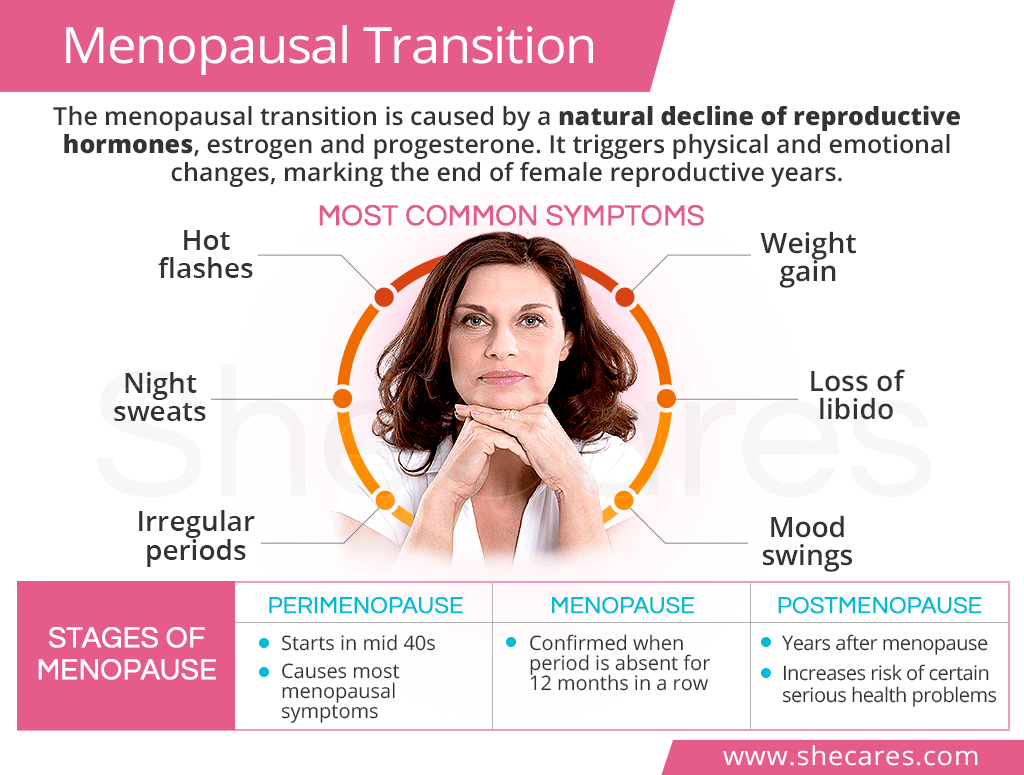What Happens During Menopause?
In short, menopause is characterized by a natural fall in levels of reproductive hormones, namely estrogen, progesterone, and testosterone, and the subsequent cessation of women's reproductive years, triggering a cascade of physiological changes.
Hormones and Menopause
As women age, their ovarian reserve, which is a definite number of eggs they are born with, starts approaching its depletion, and ovaries gradually reduce their monthly release.
Estrogen and Progesterone
As a result, the ovaries also produce less and less estrogen and progesterone that would normally guide the menstrual cycle.
In this period, reproductive hormones fluctuate erratically, causing numerous symptoms, such as night sweats, fatigue, irregular periods, and insomnia.
Testosterone
Testosterone levels in women, on the other hand, begin to fall even before the onset of the menopausal symptoms, roughly in their 20s. By menopause, they decline to about half of their previous amounts, but in a much slower and steadier pace than estrogen and progesterone.
Eventually, hormonal production by the ovaries stops from menopause onwards. To sustain other bodily functions, small amounts of sex hormones are made by other body parts, such as the adrenal glands as well as fat or nerve cells.
Stages of Menopause
When women start experiencing some of the notorious symptoms of middle age, they tend to refer to them as menopausal. However, although the menopausal transition is collectively called menopause by most, the entire process actually occurs in three distinct stages, each with different characteristics and duration. They include:
Perimenopause
It is a stage that precedes menopause and during which the majority of menopause-associated symptoms begin to appear, such as hot flashes or irregular periods.
Perimenopause usually starts in one's mid 40s and can continue for several months or even up to 10 years with 4 years being the average.
Menopause
It is defined as a point in time when a woman has gone 12 consecutive months without a period. On average, women reach menopause between the ages of 51 and 52, although it can happen several years sooner or later.
When menopause occurs at the age of 40 or younger, it is called premature menopause. When menopause occurs at the age of 45, it is termed early menopause.
Menopausal symptoms are likely to continue through this phase to a varying degree. From now on, women are referred to as postmenopausal.
Postmenopause
It is defined as the years following menopause when women's reproductive abilities have come to an end, and they can no longer get pregnant.
In the majority of cases, the frequency of menopausal symptoms lessens greatly, or they disappear. However, due to depleted estrogen levels, postmenopausal women are at a higher risk for developing potentially dangerous health conditions, as heart disease or stroke.
Causes of Menopause
Natural Menopause
The main cause of menopause is the decline of reproductive hormones. As a result of the natural aging process and depletion of the egg reserve, the ovarian production of estrogen and progesterone gradually decreases.
This brings a halt to menstruation and ovulation, whose absences signal that menopause has come and a woman entered her postmenopausal years.
Induced Menopause
In addition to aforementioned natural menopause, there is also induced menopause, which occurs through some sort of a medical intervention to treat certain health conditions, such as endometriosis or ovarian cancer, which put women at a higher risk for developing life-threatening complications.
Induced menopause can have the following causes:
Surgery, such as the removal of the ovaries (bilateral oophorectomy) with or without the removal of the uterus (hysterectomy)
Treatment, such as chemotherapy and pelvic radiation therapy
Other medications, like those to treat endometriosis
Signs and Symptoms of Menopause
Each woman's path through the menopausal transition is different. Some are lucky not to experience any bothersome discomforts, while others suffer from numerous symptoms that often disrupt their everyday functioning.
There are two key components to diagnosing menopause: symptoms, which are women's subjective reports of what they experience, as well as signs, which are identifiable markers observed or measured by a physician through medical tests.
Symptoms of Menopause
Perimenopause, the years leading up to the menopause, are the time when physical and emotional menopausal symptoms are most pronounced for the majority of women, although they can also continue into postmenopause.
Hallmark symptoms of menopause include, but are not limited to:
Signs of Menopause
Besides reported symptoms indicating the beginning of the menopausal transition, doctors also look for clear signs to confirm their diagnosis, which can be obtained through a physical exam and various diagnostic tests:
Amenorrhea, which is the absence of a period, that lasts 12 consecutive months
Elevated levels of follicle-stimulating hormone (FSH) of 30 IU/L or higher
Decreased levels of estradiol, the main circulating estrogen, of 30 pg/mL or lower
Elevated vaginal pH between 4.5 and 6
It is important to note that some of those diagnostic tests might not be conclusive as hormonal levels can greatly fluctuate during perimenopause, possibly altering the results.
Menopause Problems
Besides its important effects on reproduction, estrogen plays a key role in maintaining other bodily functions. When its levels start to decline, those protective effects might be weakened, leaving women at a heightened risk for complications, especially in conjunction with other age-related conditions, such as high blood pressure, or high cholesterol.
Heart disease
The main concern among postmenopausal women is the risk of heart attack and stroke. Estrogen naturally protects the heart vessels and the heart. So, its falling levels expose middle-aged females to the dangers of heart disease.
Osteoporosis
Osteoporosis is another health problem that is common among middle-aged women. Because stable estrogen levels are essential for the preservation of bone mass, their decline might lead to a rapid loss of bone mass and density. This, in turn, makes the bones weak and brittle, increasing the risk of serious fractures.
Incontinence
Incontinence is one of several urinary tract problems that postmenopausal women can suffer from. They might result from the loss of vaginal or urethral elasticity due to lowered estrogen levels and can cause women a great deal of stress.
Menopause Tests
In most cases, middle-aged women do not have to undergo any medical tests to confirm that menopause has occurred. The appearance of signs and symptoms often is a sufficient indication that the menopausal transition has begun. Once a woman misses her menstrual period for 12 months in a row, she is considered postmenopausal.
Some women, however, undergo certain hormone tests to rule out other possible causes of menopause-like symptoms and, eventually, confirm the arrival of menopause. These tests check the levels of the following hormones:
Follicle-stimulating hormone (FSH) and estrogen levels to confirm menopause, characterized by elevated FSH and decreased estrogen.
- Thyroid-stimulating hormone (TSH) to rule out an underactive thyroid, whose symptoms might mimic those of menopause.
Moreover, a vaginal swab can be performed along with testing FSH levels to measure the pH in the vagina, which rises during menopause.
Treatment of Menopause
Because menopause is a natural part of the aging process, it cannot be treated. Instead, various natural and pharmaceutical methods focus on relieving the symptoms and lowering the risks of developing further menopause-triggered health problems.
Natural Treatment Methods
Many women prefer to start with natural approaches, such as implementing healthy lifestyle habits, which not only can be effective and far-reaching, but also do not cause side effects.
Wholesome Diet
Eating foods that are rich in fiber, iron, calcium, and phytoestrogenic foods, which contain compounds that act like weak estrogens, can help relieve the symptoms of estrogen depletion.
Good options to include in your menopause diet are soy-based edamame or tofu, flaxseed, eggs, yogurt, and fish, as well as cruciferous vegetables, like broccoli or kale.
Regular Exercise
Regular, low-impact physical activity, like yoga, can also bring numerous benefits to menopausal women from improving their mood to preventing weight gain and relieving fatigue. They can also strengthen pelvic floor muscles, thus improving urinary incontinence.
Natural remedies
The use of medicinal herbs for balancing hormones, like black cohosh, dong quai, or red clover, can relieve notorious symptoms and protect the body from postmenopausal health risks.
Natural supplements
Natural supplements, including hormone-regulating supplements like Macafem, can nourish the endocrine glands to regulate their hormonal production and bring end to bothersome symptoms.
Pharmaceutical Treatment Options
There are also a number of medications designed to bring relief and lower the impact of the menopausal transition on women's health. The most common ones include hormone replacement therapy (HRT) in the form of tablets, skin patches, gels, and more.
Although hormone therapy can bring relief to some women, there are numerous health risks associated with its long-term use, which include heart disease and breast cancer.
Conclusions
Undoubtedly, menopause can be one of the most difficult periods in a woman's life, forcing her to cope with rapidly changing hormones and battle symptoms. However, many women around the world going through the menopausal transition have found relief in wholesome approaches, such as a healthy menopause diet rich in phytoestrogens; low-impact exercise, like yoga or Pilates; medicinal herbs, like black cohosh; and natural supplements, like Macafem. Empowered with those effective relief strategies, you will feel more open to welcome this new chapter of your life and the beginning of the new you.
Sources
- American College of Obstetricians and Gynecologists. (2015). The Menopause Years. Retrieved July 5, 2018 from https://www.acog.org/Patients/FAQs/The-Menopause-Years
- Cleveland Clinic. (2017). Menopause, Perimenopause, and Postmenopause. Retrieved July 5, 2018 from https://my.clevelandclinic.org/health/diseases/15224-menopause-perimenopause-and-postmenopause
- Journal of Mid-Life Health. (2014). Vaginal pH: A marker for menopause. Retrieved July 5, 2018 from https://www.ncbi.nlm.nih.gov/pmc/articles/PMC3955044/
- Mayo Clinic. (2018). Menopause. Retrieved July 5, 2018 from https://www.mayoclinic.org/diseases-conditions/menopause/diagnosis-treatment/drc-20353401
- Minerva Ginecologica. (2009). Hormone changes associated with the menopausal transition. Retrieved July 5, 2018 from https://www.minervamedica.it/en/journals/minerva-ginecologica/article.php?cod=R09Y2009N06A0483
- North American Menopause Society. (n.d.). Menopause FAQs: Understanding the Symptoms. Retrieved July 5, 2018 from https://www.menopause.org/for-women/expert-answers-to-frequently-asked-questions-about-menopause/menopause-faqs-understanding-the-symptoms
- Office on Women's Health. (2018). Menopause. Retrieved July 5, 2018 from https://www.womenshealth.gov/menopause/
- US Food & Drug Administration. (2018). Menopause. Retrieved July 5, 2018 from https://www.fda.gov/ForConsumers/ByAudience/ForWomen/WomensHealthTopics/ucm117978.htm
- Women's Health Research Institute. (n.d.). How Hormones Depletion Affects You. Retrieved July 5, 2018 from http://menopause.northwestern.edu/content/how-hormone-depletion-affects-you


